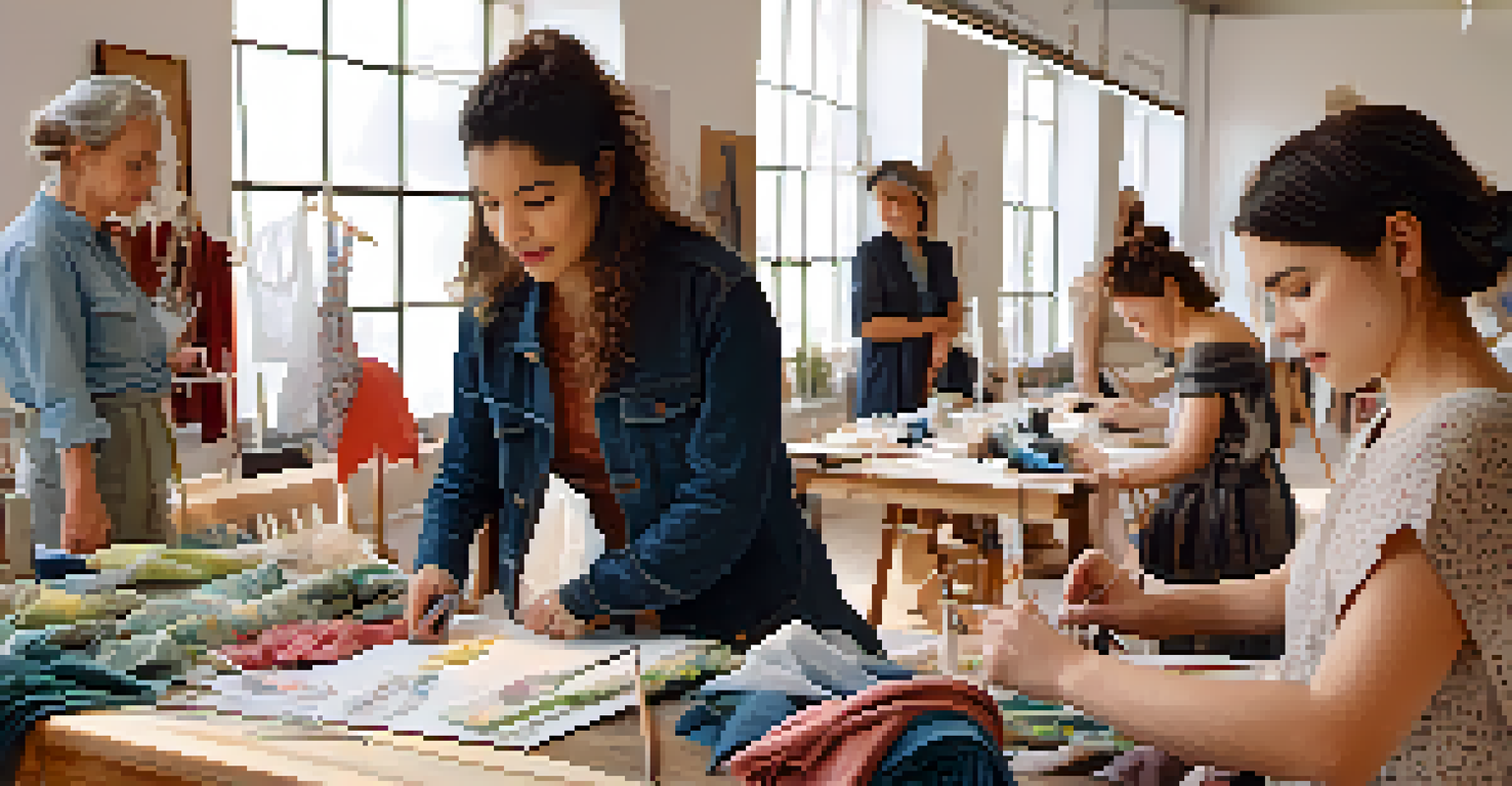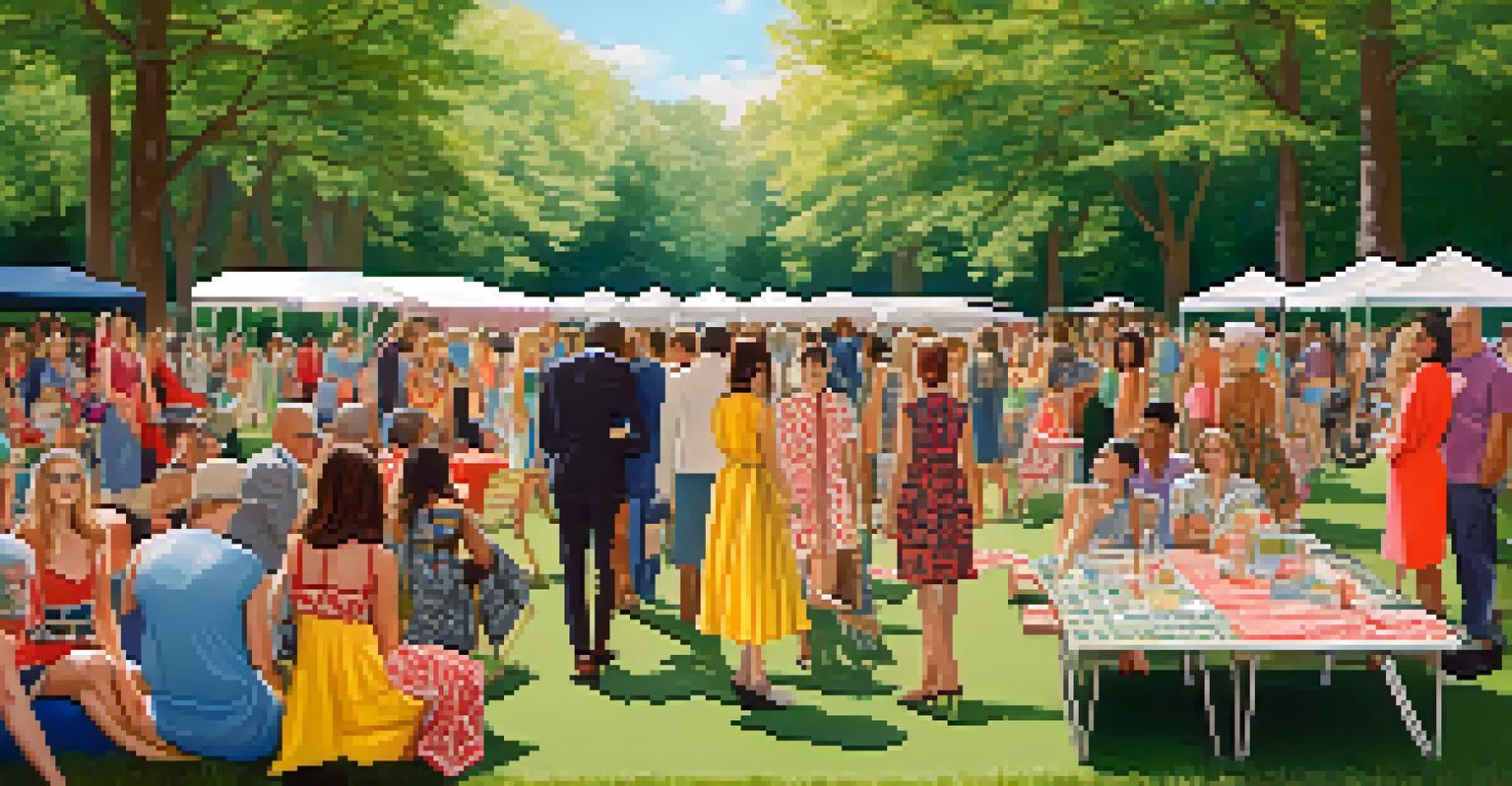Local Fashion Initiatives: Building Community at the Grassroots

Understanding Local Fashion Initiatives and Their Impact
Local fashion initiatives are grassroots movements that aim to promote sustainable and ethical fashion within communities. These initiatives often focus on utilizing local resources, supporting small businesses, and fostering a sense of belonging among residents. By prioritizing community engagement, these programs not only uplift local economies but also encourage consumers to make conscious choices in their fashion purchases.
Fashion is the armor to survive the reality of everyday life.
For instance, many cities have seen the rise of pop-up markets where local designers showcase their creations. These events not only provide a platform for emerging talent but also create an opportunity for community members to connect and support one another. As a result, local fashion initiatives can bridge cultural gaps and encourage a greater appreciation for diverse styles and traditions.
Ultimately, these initiatives represent a shift in consumer behavior, where people are increasingly valuing quality and ethical production over mass production. By celebrating local craftsmanship, communities can create a unique identity that resonates with residents and visitors alike, solidifying the importance of local fashion initiatives.
Building Community Connections Through Fashion Events
Fashion events are a powerful way to bring people together, fostering connections and collaboration among local designers, artists, and residents. Events like fashion shows, workshops, and style fairs create opportunities for community members to interact, share ideas, and develop lasting relationships. These gatherings not only promote local talent but also inspire creativity and innovation within the community.

Consider a local fashion festival where designers showcase their work while attendees enjoy live music and food from local vendors. This type of event not only highlights the fashion scene but also celebrates the broader community, strengthening ties between various groups and organizations. When people come together to support local talent, they are more likely to form connections that extend beyond fashion.
Local Fashion Initiatives Boost Community
These grassroots movements prioritize sustainability and ethical practices while uplifting local economies and fostering community connections.
Moreover, these events often feature educational components, such as panels discussing sustainable practices or workshops on upcycling clothing. By engaging the community in conversations about fashion and its impact, participants can develop a deeper understanding of their choices and the importance of supporting local initiatives.
Empowering Local Designers to Thrive
Local fashion initiatives empower designers to showcase their unique voices and styles, fostering a sense of pride in their heritage. By providing platforms for these creatives, communities encourage innovation and diversity in fashion, making it a reflection of the local culture. This empowerment helps designers establish their brands while promoting sustainable practices and ethical production methods.
The best part of fashion is that it is an expression of who you are and what you believe in.
Consider a local designer who uses traditional techniques to create modern garments, drawing inspiration from their cultural background. By supporting such designers, communities not only preserve these techniques but also promote awareness of their significance. This celebration of local talent can lead to a thriving fashion ecosystem that nurtures creativity and sustainability.
Additionally, mentorship programs can play a crucial role in supporting emerging designers. By connecting them with established industry professionals, these initiatives can help nurture their skills and provide valuable insights into the fashion world. The result is a vibrant community of designers who work together to elevate each other's success.
Sustainable Practices in Local Fashion Initiatives
Sustainability is a core principle of many local fashion initiatives, as they often prioritize eco-friendly practices. By sourcing materials locally and focusing on ethical production, these initiatives aim to reduce their environmental impact while supporting the community. This commitment to sustainability resonates with consumers who are increasingly concerned about the effects of fast fashion on the planet.
For example, some local designers use recycled materials to create their collections, turning waste into wearable art. This innovative approach not only minimizes waste but also showcases the creativity and resourcefulness of local talent. By emphasizing sustainability, local fashion initiatives can inspire a cultural shift towards more responsible consumption habits.
Social Media Enhances Local Fashion
Platforms like Instagram and Facebook help local designers showcase their work and engage with a broader audience, driving participation in local events.
Furthermore, educational workshops on sustainable practices can empower community members to make informed choices about their fashion consumption. By learning about the environmental impact of their purchases, consumers can develop a deeper appreciation for local designers and the importance of supporting sustainable initiatives.
The Role of Social Media in Promoting Local Fashion
In today's digital age, social media plays a vital role in promoting local fashion initiatives and connecting communities. Platforms like Instagram and Facebook allow designers and brands to showcase their work, reach a broader audience, and engage with potential customers. Through visually appealing content, these platforms can effectively highlight local talent and events, driving interest and participation.
Consider a local designer who shares behind-the-scenes glimpses of their creative process on social media. This transparency not only fosters a connection with followers but also encourages them to support the designer's work and attend local events. By leveraging social media, local fashion initiatives can create a buzz that translates into real-world engagement.
Moreover, social media can serve as a tool for collaboration, allowing designers to connect with one another and form partnerships. These collaborations can lead to exciting events and projects that further enhance the local fashion scene. Ultimately, social media is a powerful ally in building community and promoting local fashion initiatives.
Challenges Faced by Local Fashion Initiatives
Despite their numerous benefits, local fashion initiatives often face challenges that can hinder their growth and impact. Limited funding and resources can pose significant obstacles for emerging designers and organizers. Without adequate support, these initiatives may struggle to gain visibility and reach their full potential within the community.
Additionally, competition from larger, established brands can make it difficult for local designers to gain traction. Consumers may be drawn to the convenience and affordability of fast fashion, neglecting the unique offerings of local talent. To counter this, local fashion initiatives must effectively communicate their value and the importance of supporting the community.
Challenges Threaten Local Designers
Limited funding and competition from larger brands pose significant challenges for local fashion initiatives, necessitating collaboration and community support.
However, by fostering collaboration among local designers, businesses, and organizations, these initiatives can build a stronger network of support. Creating awareness about the unique benefits of local fashion can help shift consumer mindsets, ultimately leading to a more sustainable and thriving fashion ecosystem.
The Future of Local Fashion Initiatives
The future of local fashion initiatives looks promising as more communities recognize their value and impact. With a growing emphasis on sustainability and ethical practices, consumers are increasingly seeking out local alternatives to fast fashion. This shift in mindset creates opportunities for local designers and initiatives to flourish and make a lasting impact.
As communities continue to support local talent, we may see a rise in innovative collaborations between designers, artists, and businesses. These partnerships can lead to exciting projects that elevate the local fashion scene and create a sense of pride among residents. By fostering a culture of collaboration, local fashion initiatives can thrive and continue to inspire future generations.

Moreover, ongoing education and awareness campaigns can help further engage consumers in the importance of supporting local fashion. By sharing stories of local designers and their contributions to the community, initiatives can cultivate a deeper appreciation for the value of local craftsmanship. The future of local fashion initiatives is not just about clothing; it's about building a stronger, more connected community.